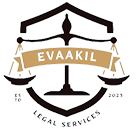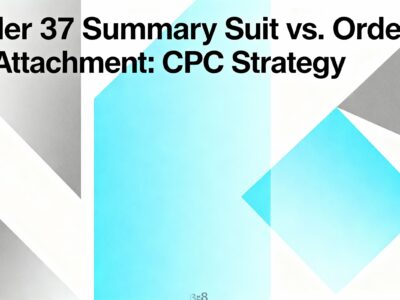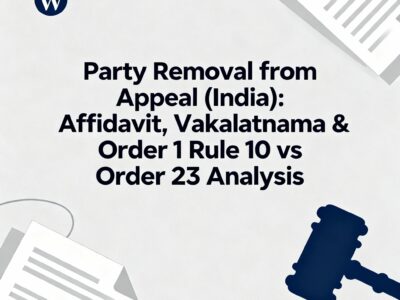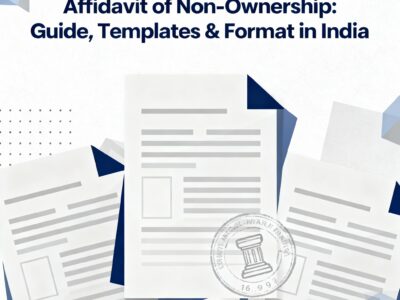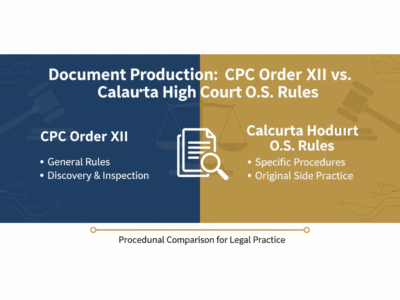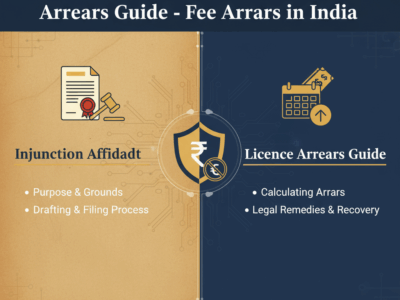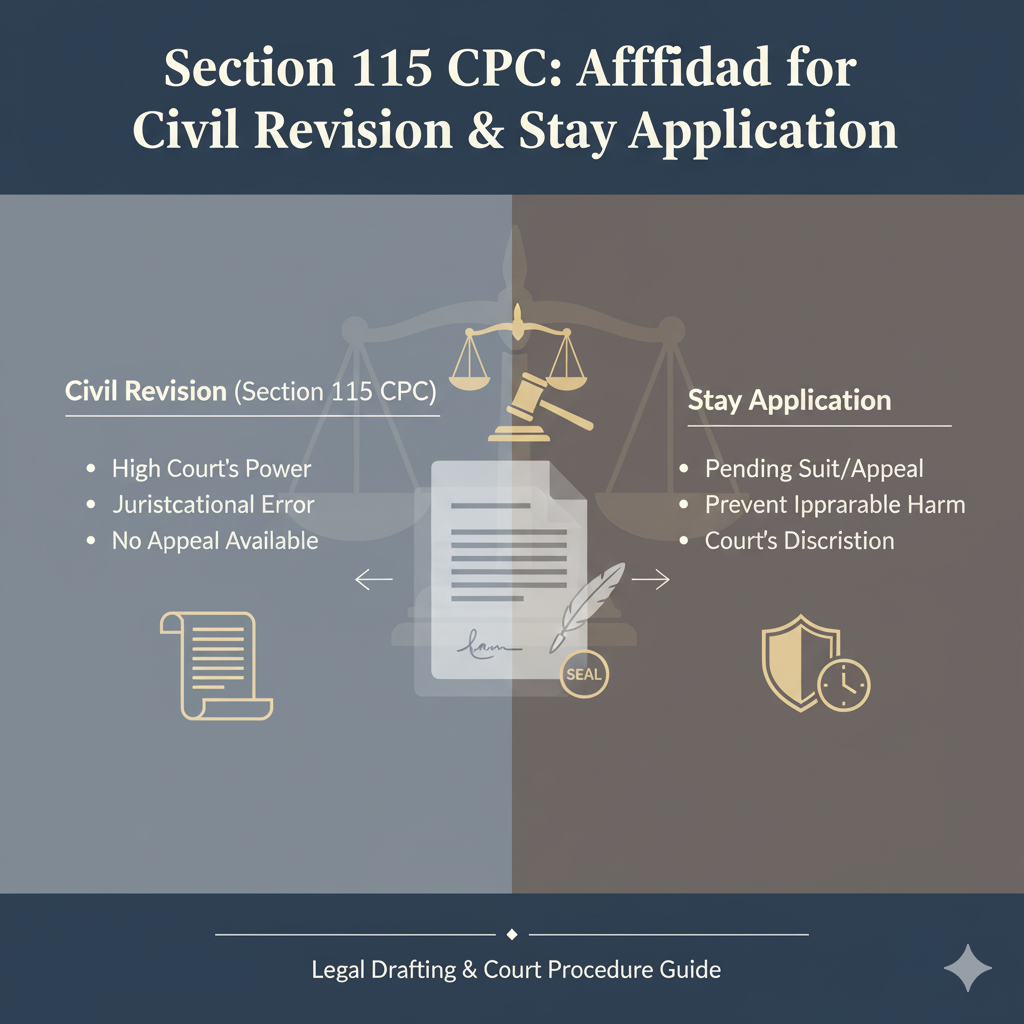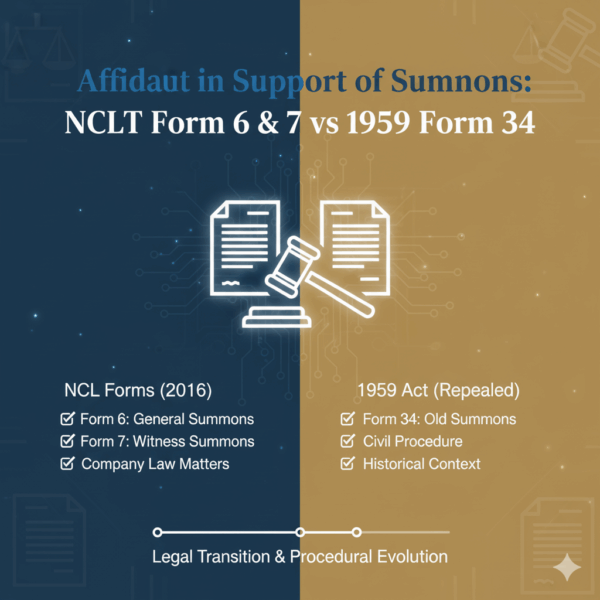Losing original share certificates can be stressful, but the process to replace them is clearly defined. This guide provides a step-by-step walkthrough for obtaining a duplicate share certificate in India. We explain the essential documents, like the Affidavit and Indemnity Bond, and navigate the critical differences between the process for listed and unlisted companies.
Lost Your Share Certificates?
A step-by-step guide to getting duplicates in India. Understand the process, documents, and key differences for listed and unlisted companies.
Your Document Checklist
Affidavit
A sworn legal statement that you lost the shares and did not sell or pledge them.
Indemnity Bond
A contract promising to pay the company for any losses if the original shares reappear.
FIR / Police Report
A First Information Report (FIR) or police complaint. (Often waived for small values).
Newspaper Ad
A public notice in a newspaper. (Also often waived for small values in listed companies).
KYC & Signature
Self-attested PAN, address proof, and a bank-verified signature specimen.
The Process: Listed vs. Unlisted Companies
The procedure is very different depending on the type of company. Select your company type to see the correct process for you.
Procedure for Listed Companies (e.g., on NSE/BSE)
This process is standardized by SEBI and handled by a Registrar and Transfer Agent (RTA). It is faster and more modern.
Key Rule: The 5 Lakh Rupee Waiver
This is the most important rule. If the market value of your lost shares is five lakh rupees (Rs. 5,00,000) or less, you are NOT required to file an FIR or publish a newspaper advertisement. This saves significant time and money. You only need the Affidavit and Indemnity Bond (plus KYC).
No More Physical Duplicates: The “Letter of Confirmation” (LOC)
Companies no longer issue physical duplicate certificates. Instead, the RTA will issue a “Letter of Confirmation” (LOC). This is the official document replacing your lost certificate.
You have 120 days from the date of the LOC to give it to your stockbroker (Depository Participant) to get the shares directly credited to your demat account. This is a required step.
No Surety Required
SEBI has banned the old practice of demanding a “surety” (a third-party guarantor). You only need to sign the indemnity bond yourself.
Summary (Listed)
- Contact the company’s RTA (not the company).
- Timeline is faster: usually within 45 days.
- No FIR or Ad if shares are worth ≤ Rs. 5 Lakhs.
- No surety is needed.
- Output: A “Letter of Confirmation” (LOC).
- Result: Shares are credited to your demat account.
At a Glance: Listed vs. Unlisted
| Feature | Listed Company | Unlisted Company |
|---|---|---|
| Governing Body | SEBI and Companies Act | Companies Act, 2013 |
| Point of Contact | Registrar & Transfer Agent (RTA) | Board of Directors / Company Secy. |
| Timeline | Within 45 days | Within 3 months |
| FIR / Newspaper Ad | Waived if value is ≤ Rs. 5 Lakhs | Almost always required |
| Surety (Guarantor) | Not allowed (Banned by SEBI) | May be requested by the Board |
| Final Output | “Letter of Confirmation” (LOC) | Physical “Duplicate” Certificate |
The Legal Foundation: Why Is This Process So Strict?
The procedure for issuing duplicate certificates is strict for one primary reason: a share certificate is proof of ownership. The company must protect itself from fraud and duplicate claims.
The Source of Law
The entire process is governed by law. For unlisted companies, it’s primarily **Rule 6 of the Companies (Share Capital and Debentures) Rules, 2014**. This rule gives the Board of Directors the power to set “reasonable terms” for issuing a duplicate, which is why they ask for so many documents.
For listed companies, **SEBI (LODR) Regulations** and circulars standardize the process, introducing the Rs. 5 Lakh waiver and banning sureties to make it friendlier for small investors.
The Purpose of the Indemnity Bond
The Affidavit is your sworn statement that you lost the shares. The Indemnity Bond is the legal consequence of that statement.
By signing it, you are entering a binding contract. You legally promise to pay the company back for any financial loss it suffers if your “lost” original certificate is ever found and presented by someone else (like a lender or a buyer). This bond is the company’s only real protection, which is why it’s non-negotiable.
The 6-Step Process Flow
Notify Company/RTA
Prepare Documents
Submit Application
Company Verifies
Board/RTA Approval
Receive LOC/Duplicate
Notify Company/RTA
Prepare Documents
Submit Application
Company Verifies
Board/RTA Approval
Receive LOC/Duplicate
Template Formats (For Reference)
Template: Affidavit
Must be on non-judicial stamp paper (e.g., Rs. 100) and notarized.
(On Rs. 100 Non-Judicial Stamp Paper)
AFFIDAVIT
I, [Your Name], son/daughter of [Father's Name], aged [Your Age], residing at [Your Full Address], do solemnly affirm and state as under:
1. That I am the registered holder of [Number] equity shares in [Company Name] Limited, under Folio No. [Your Folio No.].
2. That the original share certificate(s) pertaining to the said shares, as detailed below, have been lost/misplaced and are not traceable.
(Folio No, Cert. No., Distinctive Nos., No. of Shares)
3. That I have made diligent searches but have been unable to find the said certificate(s).
4. That I have not sold, transferred, pledged, or otherwise disposed of the said shares or the original certificate(s).
5. That the said certificate(s) were not accompanied by any signed blank transfer deed.
6. I request the company to issue duplicate share certificate(s) in my name.
I verify that the contents of this affidavit are true to my knowledge.
DEPONENT
(Your Signature)
VERIFICATION
Verified at [Place] on this [Date] day of [Month], 2025.
DEPONENT
(Your Signature)
(Sworn before a Notary Public)
Template: Indemnity Bond
Must be on non-judicial stamp paper (e.g., Rs. 200 or 500) and notarized.
(On Rs. 500 Non-Judicial Stamp Paper)
INDEMNITY BOND
This bond is executed on [Date] by [Your Name] ("the Applicant") in favor of [Company Name] Limited ("the Company").
WHEREAS the Applicant holds [Number] shares under Folio No. [Folio No.].
WHEREAS the Applicant has lost the original share certificate(s) and has requested the Company to issue duplicate(s).
NOW, in consideration of the Company agreeing to issue duplicate share certificate(s), the Applicant hereby undertakes to indemnify and keep indemnified the Company, its directors, and officers against all claims, demands, actions, losses, and expenses whatsoever which the Company may suffer as a result of issuing the said duplicate share certificate(s).
The Applicant further undertakes to return the original certificate(s) to the Company if found.
Signed and delivered by the Applicant:
(Your Signature)
[Your Name]
Witness 1:
(Signature, Name, Address)
Witness 2:
(Signature, Name, Address)
(Notarized)
Proactive Steps to Avoid Future Problems
1. Dematerialize Now
This is the single best solution. Contact a stockbroker and submit a Demat Request Form (DRF) for all your physical shares. Once in a demat account, they cannot be lost, stolen, or damaged.
2. Register a Nominee
File Form SH-13 with the company/RTA to add a nominee. This simplifies the “transmission” process for your heirs immensely, often bypassing the need for complex court documents like a Succession Certificate.
3. Update Your Details
Always ensure your current address, mobile number, email, and bank details are updated with the RTA or company. This prevents dividend warrants and official letters from being lost or returned.
4. Use Safe Custody
If you must hold physical certificates (for unlisted companies), do not keep them in a simple home drawer. Store them in a fireproof safe or a bank safe deposit locker.
Handling Complex & Special Cases
Case 1: The Shareholder is Deceased
This is a “Transmission cum Duplicate” request. The legal heir(s) must apply. This process is complex and requires combining two procedures.
Required Documents (in addition to duplicate set):
- Original or Notarized Death Certificate of the shareholder.
- KYC documents of the legal heir(s).
- A legal document establishing their right to the shares. This is the hardest part and can be:
- Will: A probated copy of the Will (a court-certified Will).
- Succession Certificate: A certificate from a competent court.
- Nomination: If a nominee was registered, this is simple.
- Legal Heirship Certificate: In some cases, with an NOC from all other heirs.
Note: The legal heirs must sign the new Affidavit and Indemnity Bond. This process can be long and requires careful legal documentation.
Case 2: Joint Shareholders
The rules depend on the situation.
- All Holders Alive: All joint holders must sign the Affidavit and Indemnity Bond. The duplicate will be issued in all their names.
- One Holder Deceased: This is a “Deletion of Name cum Duplicate” request. The surviving holder(s) must apply. They need to submit the Death Certificate of the deceased holder along with all the duplicate share documents. The new certificate will be issued only in the names of the surviving holders.
- All Holders Deceased: This becomes a “Transmission cum Duplicate” case, as described in the first box. The legal heirs of the last surviving joint holder are the ones who must apply.
Case 3: The Company or RTA is Unresponsive
If you have submitted a complete application and the company or RTA is not responding or refuses to issue the duplicate without a valid reason, you have options.
- For Listed Companies: File a complaint on the SEBI SCORES (SEBI COmplaints REdress System) portal. This is a very effective and monitored escalation path.
- For Unlisted Companies: You can file a complaint with the Investor Education and Protection Fund (IEPF) authority or, as a last resort, file a petition with the National Company Law Tribunal (NCLT) for “Oppression and Mismanagement” or to compel the company to update its register.
Case 4: Shares Lost by a Bank or Lender
If you pledged your shares with a bank (as collateral for a loan) and the *bank* lost the certificates, the responsibility shifts to them.
- The bank must file the FIR.
- An authorized official from the bank (not you) must sign the Affidavit and Indemnity Bond on the bank’s letterhead.
- The bank is responsible for all costs.
- The duplicate certificate will still be issued in your name but may be sent to the bank if the pledge is still active.
Frequently Asked Questions
This is the most important statement for the company. You are swearing under oath that you did not “pledge” (use as collateral for a loan) or sell the shares to someone else. The company’s biggest fear is issuing a duplicate to you, only for the “lost” original to be presented by a lender or new buyer. Your affidavit gives them a legal basis to act against you if your statement is false.
This is a “Duplicate cum Transmission” case, which is very complex. Please refer to the “Handling Complex & Special Cases” section above for a detailed breakdown. You must first establish your legal right to the shares (as an heir or nominee) before the company will even consider the duplicate share request.
The process is the same, but the execution of documents is different. You must get your Affidavit and Indemnity Bond notarized and then “apostilled” or “attested” by the Indian Embassy or Consulate in your country of residence. This gives the documents legal standing in India.
Dematerialization. If you still hold any physical share certificates, you should immediately contact a stockbroker (Depository Participant) and submit a Dematerialisation Request Form (DRF). They will convert your physical paper into electronic holdings in your demat account. This eliminates all risk of loss, theft, or damage and makes selling or transmitting shares to heirs much simpler.
